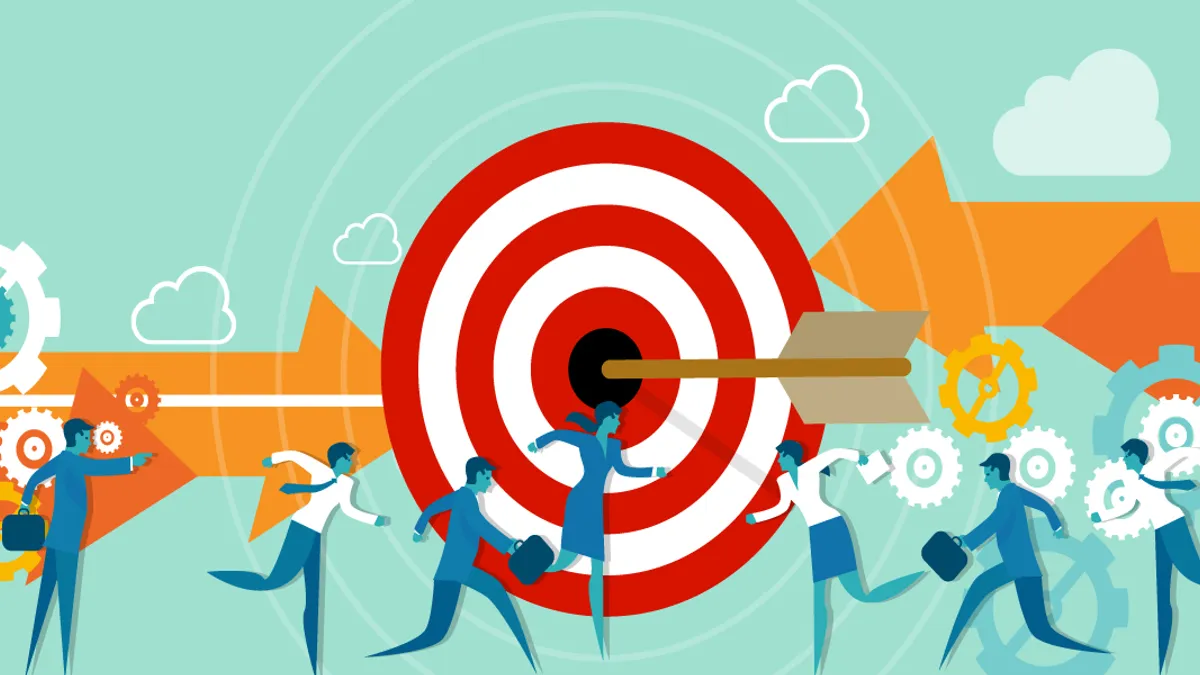Today’s organizations are at a crucial crossroads: invest in and adapt old-school talent management processes now or face the consequences. That statement isn’t meant to ignite fear. Instead, it’s meant to jolt us as HR and Learning and Development professionals into positive action toward process change that’s long overdue.
What does all this have to do with performance management and a competency framework? In my previous article here on HRDive, I outlined the reasons why the traditional performance management process is in need of a complete overhaul. The article looked at how the performance management process is shifting to complement and connect to a continuous learning cycle and adapt to employees’ new-found expectations that their company of choice foster a culture of openness, engagement, and transparent career and professional development paths that are tied to company goals and objectives.
It’s not lost on anyone that old methods of performance management no longer deliver the experience or results that companies and employees are looking for. There is a long list of reasons why companies should connect learning to performance … but at its core performance management should:
- Create a process in which people are enabled to perform to the best of their abilities.
- Foster a shared understanding of how individuals contribute to an organization's goals and objectives.
- Offer a continuous, transparent, and trackable feedback loop between managers and their employees.
- Align your workforce strategy, build competencies, improve employee performance, and drive better business results.
My hope for this article is that you walk away with a firm foundation and governance model that outlines the competencies, skills, behaviors, and attitudes that are tied to the roles/jobs within your organization.
Competency vs. Skills: The Same or Different?
Before we dig in, let’s level-set on competency and skills. Are they the same, complementary, completely separate?
A competency is generally defined as a combination of knowledge, skills, abilities, and behaviors that enables an individual to perform a task or an activity successfully within a given job. Competencies should be observable and measurable, and thus are essential in terms of defining job requirements and recruiting, retaining, and developing staff.
Defining Competencies
To fully understand competencies, it’s important to define the four components that comprise competencies:
- Knowledge — The awareness of facts, truth, and principles gained from formal training and experience.
- Skill — Skills are the proficiencies developed through training or experience. We can develop our skills through the transfer and application of knowledge.
- Ability — Abilities are the innate or natural qualities that a person brings to a task or situation.
- Behaviors —Behaviors may also fall into the category of soft skills. Behaviors can be innate or taught and developed through demonstration/modeling, instructions, role-play/rehearsal, and feedback.
Developing Your Company’s Competency Framework
Knowing you need to extend your competency framework to support continuous performance improvement is just the first hurdle. Steve Jobs put it best when he said “To me, ideas are worth nothing unless executed. They are just a multiplier. Execution is worth millions.”
So, what does execution look like? How can companies develop a competency framework and adapt to a continuous performance cycle that’s interconnected and woven through an employee’s holistic talent development experience?
I like to break it down into a three-phase process.
A Three-Phase Approach to Developing a Competency Framework
Phase 1 | Define Core Competencies/Skills
This first phase is likely the most tedious. This phase requires you to capture and then define the core competencies that are critical to the success of your employees and business regardless of the level. These are often considered “Core Competencies.” They could be things like Core Values or related to those high-level company/waterfall objectives set at the beginning of the year. These competencies are core to your company’s DNA.
Phase 2 | Define Relationships between Competencies and Jobs
Once you’ve identified and defined your Core Competencies, it’s time to dig in further to the individual jobs by roles or levels. You might hear this defined as Functional Competencies. This step can look overwhelming at first; you’re thinking “that’s a lot of jobs!” My recommendation is to start small and chip away at with a weekly project plan. Or, consider starting at the Job Level (Individual Contributor, Manager, Director, VP/Executive). Slicing your Competency Framework by job level allows you to focus on those four-to-five areas for defining competencies expected at that level. Those then become a template that can be used as you expand job roles and those more individualized functional elements.
As you identify core competencies, it’s also important to develop a clear definition of what success looks like when that competency is acquired and exhibited. A good question to ask is what behavioral observations can be made or captured that would signal or indicate that the competency has been achieved. Doing the extra step of defining the metrics for success will provide employees, their managers, and leaders with clearer expectations and offer a more objective approach to measurement.
Phase 3 | Connect Competencies to Training Courses, Content, and On-Demand Learning Opportunities
Phase three is where things get fun for learning and development teams. During this phase, you’re looking across the Core & Functional Competencies and identifying training courses, content, personalized learning and other on-demand development opportunities based on the identified performance outcomes. This is great for teams who already have a robust library of content. If not, phase three is also where L&D teams can run into roadblocks. There has to be an honest conversation about the library of training and development content available.
Why is this so important? You can have your entire workforce complete all of the same training, however, we will all have different performance outcomes - largely due to the innate skills and strengths that lie within each individual. Just because we all read the same book or watch the same video, doesn't mean we learned the same things. We internalize the things that resonate most with us. By connecting the competencies to training, you're able to better fill in the gaps that occur - isolating the specific competency or skill area where each employee is in need of development and connecting them to content which has the most alignment and impact for their individual situation.
Doing this in the context of a continuous performance management process ensures that employees are receiving quality, real-time feedback, and alignment needed to move forward with confidence, clear direction, and opportunities to develop and exhibit a competency.
A Competency Framework Should Not be Developed in a Vacuum
It’s important to remind yourself that this Competency Framework cannot be completed overnight nor should it be developed in a silo. Collaboration and the shared effort of teams and leaders across the organization are crucial to accountability, buy-in, and an overall commitment to success.
Leveraging the interconnectedness between competencies, learning, and an objective measurement model to transform the performance management process is a journey. It requires companies to dive deep into their job skills’ strengths and gaps, identify and define their core and functional competencies, and design personalized employee learning, talent, and career development programs. It will also require HR and Learning and Development teams to be more aligned in order to support the change management process that must take place. That partnership is the key to successfully rolling out the new governance while keeping everyone not only engaged in the evolution but truly seeing the value and direct benefit to their own careers.
About Matthew Brown
Matthew Brown is the VP of Learning and Brand Success at Schoox. Matthew’s has 15+ years in IT, HR, Learning & Development, and Talent Management, across multiple industries, with a majority of that time being focused on the hospitality and restaurant industry. Matthew brings his unique blend of technical skills to the world of HR and Training, allowing for an innovative approach to the integration of people, processes, and tools. Matthew has led numerous training initiatives, stood up complex HR and IT Enterprise SaaS Solutions and led countless program rollouts. His passion for Learning & Development combined with a unique blend of technical and business expertise allow him to bring a fresh take on the business of People Practices. In his spare time, Matthew enjoys volunteering at several community non-profit organizations and spending time with his family and pets.
About Schoox
Schoox is the only modern, cloud-based learning and talent development platform designed to unlock employee potential and accelerate business results for even the most complex company structures. Founded in 2012, the company’s six core solutions solve a combination of human capital management challenges by combining Learning Engagement, Content Curation, Social Collaboration, Performance Management & Succession, Career Development, and Business Impact into one unified platform. Today, SchooX empowers excellence in learning and talent development for 8.5 million users across 120 countries in companies like Subway, Kia, Phillips66, Red Lobster, Celebrity Cruises, First Watch, Hopdoddy, Flix Brewhouse, and more. To learn more, visit https://www.schoox.com/.










